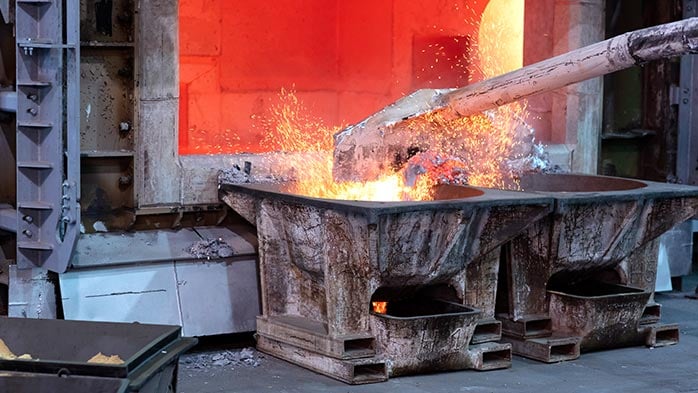Four months after it initiated a Strategic Alternative Process, US Steel (USS) has agreed to sell itself to Nippon Steel Corp (NSC). Assuming the satisfaction of regulatory and stakeholder approval, this transaction is expected to take two to three quarters to close.
Upon a successful closure, we expect this buyout will be transformative for NSC as it firmly positions it as a high-quality steelmaker in the US market and it becomes the third largest steelmaker in the world. Additionally, the ownership of these assets by NSC will continue to keep the steel market in both the USA and North America competitive for buyers, which will support further manufacturing growth from reshoring initiatives.
Valuation is on the high end yet inclusive of future incremental growth
The equity value of this deal is $14.1 billion, nearly double what Cleveland Cliffs initially offered this past August. In terms of an enterprise value of $14.9 billion, we see the valuation on the high end, yet it does incorporate visibility of incremental growth via current investments.
On 27 October, USS announced 2023 Q3 earnings alongside 2024 EBITDA expectations of $2 billion. In addition to this EBITDA, it has several investments underway with full year EBITDA projections in 2026, though some will be running at a full run rate before then. These projects and EBITDA include:
- Gary Works Pig Iron Machine, $30 million
- NGO Electrical Steel, $140 million
- Dual Coating Line, $60 million
- Big River 2, $650 million
In 2026 the full EBITDA run rate is $880 million, though USS expects $830 million EBITDA from these projects in 2025.
There are many ways to value a company. One generic way is to look at the enterprise value (market capitalisation plus net debt) divided by total capacity. This measure is quite basic as it does not take into account the margins associated with various products. A better way to value these types of transactions is using a multiple on near term EBITDA to come up with an enterprise value. Industrial companies are often valued on a multiple of five to eight times EBITDA, with variations depending on a number of factors such as the competitive landscape of the market. In the USA, steelmaking is consolidated primarily among four producers and strict trade laws severely limit foreign competition. As an example, HR coil prices in the USA are currently around $400 /st higher than in Europe. Due to this structure of the US market as well as USS owning iron ore, one can argue for a higher multiple.
If a multiple of 6 is given to the current 2024 EBITDA of $2 billion and a discounted multiple of 4 is given to the incremental $880 million EBITDA in 2026, we get an enterprise valuation of $15.5 billion ($12 billion plus $3.5 billion). Based on these calculations as well as knowing that the incremental growth has already started to be achieved today, we see the current valuation as within a normalised range.
Steel buyers have reason for optimism as new entrant keeps the market competitive
Nearly 70% of steel sheet, the products produced by USS today, goes into manufacturing end markets. This includes automotive, appliances, containers, machinery, and more. Further, non-residential construction in 2023 has been led by the building of new manufacturing facilities. Clearly, manufacturing is a key source of steel demand in the USA today as well as in the near future.
For these various manufacturing sectors to be competitive, they need competitively priced inputs such as energy and materials, like oil, natural gas, and steel. Some of the other potential buyers of USS would have led to further industry consolidation, which typically leads to tighter supply and higher prices. Since NSC is replacing USS and not adding further industry consolidation, we see this transaction as a positive for steel buyers as it supports a competitive steel supply environment.
M&A as strategy can be a substantial tool
Mergers and acquisitions (M&A), or the trading of portfolio assets, has been shown to be the greatest contributor to net present value while lowering an entity’s risk of failure. There were as many as five companies bidding over $40 /share for USS and possibly others looking to play a role in parcelling out the assets. Due to this interest as well as record mill earnings over the past few years, we may see further M&A interest in other assets in the coming year.
A full buyout is possible for some of the smaller steelmakers, though we may also see some trading of assets or use of joint ventures to better take advantage of industry valuations.
The completion of this buyout will require jumping through some bureaucratic hoops
The NSC buyout of USS will take time to close and it doesn’t come without some risk. We expect continued noise to come from both the union as well as some politicians. What should help NSC with politicians is that it already operates eight companies in the USA and employs nearly 4,000 people. We do expect that NSC will continue to advance low-emissions steelmaking by further investing in raw materials, processes, and technology that will be a benefit to steel consumers in the USA.
Issues from the union and politicians are one and the same as neither truly has a case to cancel this agreement. The Senators who have already spoken up about this see the union workers as votes. While there is a valid point that steel making does represent national security, the government can quickly use emergency powers to take temporary control of these assets if required.

















